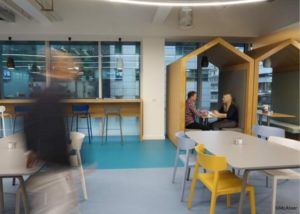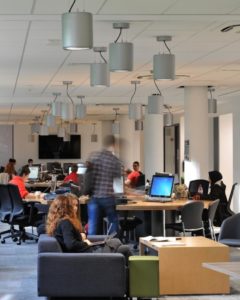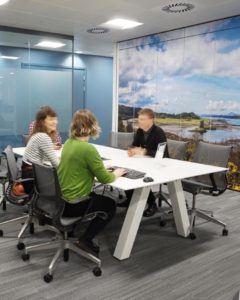That’s all incredibly important for creating a healthy environment, or the perception of a healthy environment. It can result in happier, more engaged staff who in turn can report an increase in productivity. There’s more to workplace wellbeing, however.
Good health is not just physical health. Other factors such as employment safety or financial security can have an impact on health and wellbeing. As does psychological safety and supporting mental health.
As our working environment evolves from the physical manifestation of the hierarchical organisation chart to one where flexibility is key; where the look and feel become ever more domestic in certain areas; and where the war for talent has seen the workplace environment and culture as differentiators, new roles are springing up in large organisations.
Roles such as Head of Workplace Experience or Curator of Workplace are being advertised. As much as these roles are concerned with events, spaces and community, there is an ever-increasing emphasis on creating a holistic supporting environment for everyone. The Barclays campus in Glasgow is a perfect example of placing neurodiversity at the centre of the design intent.
Large financial institutions are already seeing the benefits of having a diverse workforce and, all organisations need to think about the workplace as containing a landscape of spaces to support a range of needs. It means variety, it means choice, it means creating areas where there is more stimulation or less, and it means thinking of all the senses and, if possible, having areas where there is some element of control.
Planned spaces where people can spend time doing nothing in a safe environment, free from distraction, including technological distraction, are becoming commonplace in most workplaces. Formerly the preserve of those organisations who interacted with the public and for whom the subject matter might often be life or death, these decompression spaces are popping up in more and more workplaces, even those where the workplace culture was historically on the more traditional end of the spectrum.
Access to these spaces if they exist when in the workplace is fine, but nowadays the workplace for many people can mean the office, a client site or a desk at home for several days a week. For those who are working in a more hybrid manner, pastoral care can place extra burden on line managers who will not see teams physically day-in and day-out.
During the pandemic, loneliness became a key talking point in workplace wellbeing, with some of our clients admitting during workshops and interviews that some of their staff were actively disengaging, with cameras being turned off during Teams calls.
In each of Space Solutions’ workplaces and sites we have people with up-to-date First Aid training certificates and across the organisation we have trained Mental Health First Aiders. But the role of checking in on the mental health of colleagues is actually the responsibility of all of us. Much as we often dismiss the first five minutes of Teams calls as being unproductive and concerned with trivialities, if it is the only time we ask our colleagues how they are doing then it is most definitely productive in the long run.
The percentage return on investment for corporate wellbeing in the workplace programmes varies considerably according to reports and it can be difficult to quantify the results. It is probably nigh on impossible when it comes to something as intangible as the simple act of talking to a colleague, but we can be sure that the benefit would far outweigh the cost.
So how does the importance of workplace wellbeing stack up against the data from HR business leaders in recent years? The results are actually quite surprising according to the CIPD’s Health and Wellbeing at Work 2022 survey. The number of HR professionals who think that wellbeing is on the agenda of senior leaders has fallen from 75 percent to 70 percent in the past year. There has also been a drop in the proportion of HR professionals who think senior leaders encourage a focus on mental wellbeing through their actions and behaviours, falling from 48 percent in 2021 to 42 percent in 2022.
Whether it is in creating the right workspace or making time to communicate, can businesses really afford not to take wellbeing in all its forms seriously?




